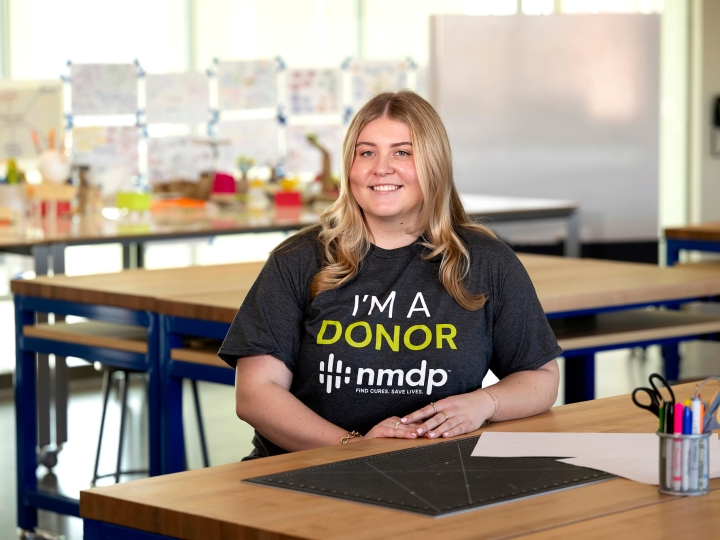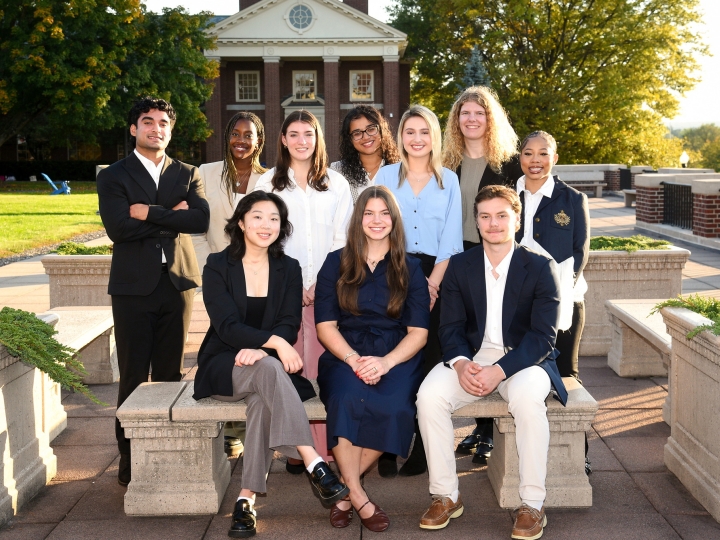Honoring Edward McKnight Brawley, Bucknell’s First African-American Graduate
May 10, 2017
"Today, we celebrate black excellence," said Nneoma Ibezim '18, president of Bucknell's Black Student Union, at the unveiling of a new campus landmark that honors the legacy of Bucknell's first African-American graduate, Edward McKnight Brawley, a member of the Class of 1875.
"This term embodies symbolic and physical examples of success, pride and perseverance," she continued. "Dr. Edward McKnight Brawley's black excellence was being the first black student to graduate at Bucknell. Can you imagine what that must have felt like? He paved the way for students to make their own firsts at Bucknell."
Located outside of the Vaughan Literature Building, the installation features a bust of Brawley, who went on to earn a master's degree from Bucknell in 1878. It also commemorates the 1958 visit to campus of civil rights activist Martin Luther King Jr. The sculpture is the centerpiece of the installation, which includes Brawley's and King's words on the pedestal, a new seating area and a listening post where visitors can hear about these milestones in Bucknell's history.
Brawley attended Bucknell before the end of the Reconstruction, a time when going to college was all but impossible for many African-Americans. He left a legacy for his family, for Bucknell and for higher education. Following his graduation, Brawley became a minister and religious scholar and worked as a journalist. He served as president of Selma University and Morris College, which he helped found. His son, Benjamin Brawley, was a noted scholar, author, college professor and the first dean of Morehouse College.
In 1993, Bucknell's Black Alumni Association (BAA) established the Brawley Fund, which provides grants to assist students who have been historically underrepresented in activities such as workshops, research opportunities, internships and off-campus study. In 2015, the BAA celebrated the 140th anniversary of black history at Bucknell, honoring Brawley's legacy throughout Homecoming Weekend alongside several of his descendants.
The power of those events led Professor Carmen Gillespie, English, to propose commissioning a sculpture to serve as a more visible and permanent way to honor Brawley's legacy. "When I met the family during Homecoming, I thought that Bucknell should recognize Brawley's accomplishments and note that the University was the first extant private school in Pennsylvania to admit an African-American student," she said. "It is equally essential to recognize the inequalities of the past and how much work we must continue to do to ensure that Bucknell becomes the institution Brawley and King both advocated for in their lives and work."
Gillespie drove the project forward, securing support from the Office of the President and the BAA, and collaborating with Professor Joe Meiser, art & art history, Provost Barbara Altmann, the Griot Institute for Africana Studies, the President's Diversity Council, Development & Alumni Relations, Communications, Facilities and the Samek Art Museum.
'A magnificent tribute'
Meiser designed and sculpted the bust of Brawley, incorporating feedback on his initial digital design from Brawley's great-granddaughter, Lee McCray, and other family members.
"Placing this sculpture at the center of campus is a physical reminder of these particular milestones, and a more general reminder that equality can't be taken for granted — that we must remain vigilant in our efforts to create an inclusive society where everyone can thrive," said Meiser.
Once the digital design was complete, he sectioned the piece into 10 different parts and 3D-printed each one, including the sculpture of Brawley's face, which took more than 50 hours to print. Meiser glued the pieces together and then made a mold in order to make a clay version, which he finished by hand. The bust was cast in bronze by Stratton Sculpture Studios in Philadelphia.
After learning of the honor her great-grandfather's legacy would receive, McCray represented her family at the unveiling. "My greatest hope is that this bust will inspire student beneficiaries of his legacy from all cultures, races and creeds to contemplate how they can personally contribute to advancing total integration and acceptance of all people in our society, regardless of origin," she said.
BAA President Kendy Alvarez '06 attended the commemoration and expressed the sculpture's significance on behalf of its members. "The Black Alumni Association is proud to have supported the development of this sculpture and will remain committed to seeing its deeper meaning reflected in Bucknell's campus climate and culture for years to come," said Alvarez. "Edward McKnight Brawley began an enduring history of academic excellence among black students at Bucknell. It serves as a reminder to all Bucknellians to carry on the legacy of diversity and inclusion so central to the success of our campus community."
At the event, before Gillespie cut the ribbon and the sculpture was revealed, President John Bravman read from the Gettysburg Address, invoking Abraham Lincoln's words, which honored those who had come before and who gave their lives to advance equality. "May all of us at Bucknell, reminded daily by this new magnificent tribute, be up to this solemn task," he said.

